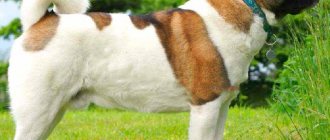Labrador
The history of the breed dates back to the 19th century. It is believed that the ancestors of modern Labradors were the so-called “little Newfoundlands.”
It was these dogs that were brought to Great Britain, where, as a result of their crossing with curly-coated retrievers and, probably, English foxhounds and setters, Labradors were bred.
Description
Labradors are well-built dogs with regular proportions, a large head, a broad chest and powerful limbs.
Despite the good-natured and attentive look of representatives of this breed, their restrained strength and willingness to act cannot go unnoticed.
The average life expectancy of Labradors with proper care and suitable living conditions is 12-14 years.
Adults grow to 54-57 cm at the withers and weigh 27-40 kg.
The breed standard
allows for minor deviations in growth.
Exterior
Description of the exterior in accordance with the FCI system :
- the body is slightly stretched, the back line is straight, the lower back is strong and wide;
- chest of moderate depth, rounded ribs;
- the skull is moderately wide, there are no rough lines, the transition from the forehead to the non-pointed muzzle is clearly defined;
- jaws are well developed, scissor bite;
- the limbs are straight, the shoulders are long and oblique, the paws are arched;
- eyes are medium-sized, hazel or brown;
- ears are hanging, medium size, set far apart;
- the undercoat is waterproof, well developed;
- The outer hair is dense and coarse, without waves or fringes.
The coat color can be deep brown, light or black.
For dogs of fawn and chocolate color, brown pigmentation of the nose is allowed .
Character
Labradors are good-natured and playful dogs. Their optimism and cheerful attitude help create an atmosphere of happiness, calm and harmony in the family.
Almost constantly being in a good mood, Labradors are not characterized by despondency and passivity . These are active dogs that enjoy playing with their owner or on their own.
At the same time, they absolutely cannot stand loneliness and need constant communication and attention.
Labradors are smart and quick-witted animals that are easy to educate and train. Moreover, they themselves love it when their owner works with them and try with all their might to please him, accurately following all commands.
What do you need to know when choosing a puppy so as not to be confused between these breeds?
To choose a pet from one of the presented species, you need to pay attention to the following features:
- Wool quality. Remember that the Labrador has short, straight, dense hair with a soft, dense undercoat. If you notice waves or feathering, it means you have a golden or mixed breed.
- Color of the dog. Remember that goldens do not come in a brown shade, much less black. The name of the breed indicates this feature. The only exceptions may be crossbreeds. However, in the future they will not demonstrate the necessary physical and mental characteristics inherent in purebred animals. You are more likely to buy a black or chocolate Labrador from a nursery.
- Tail elevation angle. In Goldens it forms a slight curve in relation to the body; in Labradors it usually rises above the line of the back. It's easy to check: play with your puppy. When in a good mood, these dogs actively wag their tail.
When you come to the nursery to pick up a future pet that is more than two months old, you can do a small test. Take any toy, show it to the baby, throw it forward a couple of meters and order him to bring it. The Labrador will rush after her as soon as he sees her. Golden will wait a while and only then go for the item.
Golden retriever
For a long time, it was believed that golden retrievers owe their appearance to the Scottish Lord Tweedmouth, who claimed that Russian shepherd dogs he acquired at one of the circus performances in 1858 were used in breeding the breed.
However, in the 20th century. it became known that Tweedmouth bought a golden puppy and crossed it with a spaniel, resulting in golden puppies .
Bloodhounds, black retrievers and Irish setters were also used to develop the breed.
Description
Strong bones, harmonious and symmetrical physique, confident movements and an attentive, friendly look - this is what catches your eye when you see golden retrievers.
Representatives of this breed live on average 10-12 years.
The height of adult individuals at the withers is 51-61 cm, and weight is 25-41 kg.
The breed standard does not have clear regulations regarding the body weight of Golden Retrievers.
Exterior
Breed standard:
- the head is proportional to the body;
- the skull is slightly convex, wide, with a clear transition from the forehead to the muzzle;
- the muzzle is straight and long;
- ears are rounded at the ends, hanging, set at eye level;
- jaws are strong, scissor bite;
- dark brown eyes with the same rim;
- neck with developed muscles, medium in length;
- the legs are powerful, muscular, the length of the shoulder blades is equal to the length of the shoulders, the elbows are adjacent to the body, the shoulder blades are laid back;
- The coat is straight, smooth or wavy, the undercoat is dense.
The standard allows any coat color, except dark red and mahogany.
Character
Golden retrievers are not known for their aggressive behavior. They are friendly to everyone without exception, adore their owners and strive to spend as much time as possible with them. These dogs are extremely difficult to tolerate separation and loneliness.
CAREFULLY!
If the dog is required to perform guard and security functions, then golden retrievers are not the best choice.
Representatives of this breed will notify about the appearance of strangers with a loud bark, but at the same time they will prefer to make friends with them than to defend their owners.
Goldens are distinguished by a high level of energy and a love of active, active games. They love water and enjoy participating in water activities, satisfying their hunting instincts.
Due to their high intelligence, retrievers can be trained without problems . Today, these dogs are often used as guide dogs or therapy dogs.
What are the differences?
There are several major differences between Labradors and Golden Retrievers related to their appearance and personality.
Coat type and what they look like in the photo
The coat of Labradors is covered with a specific waxy coating, characteristic of frequently swimming dogs. The guard coat is thick, elastic and dense, without curling or waviness.
Golden retrievers have a more decorative coat: it is shiny and slightly wavy . Beautiful feathering is clearly visible on the tail, neck, hips, and back of the forelimbs.
Body type
Labradors have a dense, muscular body and strong bones . They have a wide chest and back and a short loin, ears are slightly shorter and set higher, the head is larger, and the muzzle is less elongated.
The physique of goldens is more graceful. They have a longer neck, and some standards provide an angled transition to the tail.
The limbs of representatives of this breed are more proportional and better adapted to fast running..
Temperament and training
Both breeds are friendly, cheerful and lack aggression, but Labradors require a more active lifestyle and more exercise.
Both Labradors and Golden Retrievers respond well to training..
Minor problems may arise during training with Labradors - due to increased playfulness, representatives of this breed can be distracted, so you will need to show patience and restraint.
How much do they cost and where to buy
The market is not the place to buy Labrador and Retriever puppies. You can choose a healthy pet from quality producers only in specialized canine nurseries and professional breeders. Information about them can be found on the Internet on sites specializing in these issues, and from the organizers of dog shows.
The Retriever Club is considered one of the best golden dog kennels in Russia. Its breeders guarantee the purity of the breed and warn about the presence of abnormalities in the puppy, if any. Individuals for mating are selected strictly according to certain criteria. A puppy that meets all the requirements receives a pedigree, which ensures its participation in various competitions.
For your information! The cost of puppies from purebreds with good pedigree parents ranges around 400 USD. e.
Despite the differences between these breeds, both dogs require sufficient living space and daily exercise. Future owners must foresee and take into account all the factors and understand exactly what a retriever and a Labrador are, what is the difference between these wonderful dogs.
What are the similarities?
In addition to the fact that both breeds were bred for the purpose of hunting and their main task was to bring and serve game to the owner, these dogs have some other similarities:
- lack of qualities suitable for guard and military service;
- love of water games;
- high level of intelligence;
- good-natured character;
- ability to get along with other pets and children;
- endurance;
- subtle sense of smell;
- ability to learn.
They also have common exterior features, for example: wide heads proportional to the body, hanging ears, and a scissor bite.
The so-called “soft mouth” is another common feature of these breeds, bred specifically to avoid damage to game.
Which breed is best suited for indoors and outdoors?
The calm nature and lower need for exercise of retrievers make them more suitable for apartment living.
Labradors can also be kept in an apartment , but only if the pet is provided with constant mental and physical employment . These dogs need daily walks, active games, and repetition of learned commands.
Chaining is not acceptable for either Retrievers or Labradors.
Expert opinion
Kozhevin Semyon Kirillovich
Expert dog handler.
Of course, it is impossible to unambiguously describe absolutely all representatives of the breed - each animal is individual. At the same time, there are certain general characteristics inherent in the breed as a whole. Thus, Labradors are much more emotional than golden retrievers; they literally cannot control themselves when they are overwhelmed by emotions. They need active walks - their absence negatively affects the health and character of dogs. Goldens, although they love everything around them no less, behave more restrained and do not need physical exercise so badly.
Attitude towards children and pets
Both Labradors and Goldens are distinguished by their friendly nature and the ability to easily get along with absolutely everyone - they get along with other dogs, cats, and rodents without any problems. Problems with birds may arise, but they can be solved with the help of education.
Both breeds are characterized by a love for children, but it is important to understand that if we are talking about children under 10-12 years old, then it is better to choose a golden retriever.
These dogs are calmer and more balanced and will be able to tolerate more children's pranks.
Labradors, on the other hand, are more energetic and active dogs; they cannot always control their body and emotions, especially when expressing love.
Representatives of this breed will need a long training in self-control and the presence of children, otherwise, in a fit of emotion, the pet may accidentally push the child or grab his hand, which can frighten the baby.
Which breed is more obedient and easier to train?
The types of dogs presented are easy to train. Labradors and retrievers have approximately the same cognitive abilities, they are among the top ten domestic animals with the highest intelligence, and they easily learn various commands, including such complex skills as “Fetch” and “Voice.” Training of such individuals can begin from the age of two months. A person can easily cope with this task on his own. Only those dog breeders who have picked up an adult dog from the street may have some problems with its upbringing, which an experienced dog handler can solve.
To achieve success with puppies, the owner needs to take into account the temperament of the chosen breed. So, with Labradors, he will need to play more and conduct long training sessions, while calmer goldens will benefit from average physical activity and short but frequent exercises.
Video: How is a Labrador Retriever different from a Golden Retriever?
Who is more picky about feeding?
Both Labradors and Golden Retrievers are practically omnivorous dogs. It is important to take this into account and prevent feeding your pets food from the common table and overfeeding - representatives of both breeds are prone to food allergies and obesity.
It is necessary to develop a feeding regimen and create a balanced diet and stick to them .
History of the origin of breeds
The Labrador and the Golden Retriever belong to the same canine group, Retrievers, but are representatives of different breeds. Labrador was brought to England from the Canadian island of Newfoundland. He helped the fishermen pull their nets and get fish out of them. Actively used as a draft and working dog.
Golden Retrievers were bred by the English Lord Tweedmouth. He set out to get dogs with bright colors so that hunters could distinguish them against the background of peat bogs. His efforts were crowned with success and golden retrievers appeared. They began to be used as gun dogs, which picked up shot birds and brought them to the hunter. This function is reflected in the name of the breed: translated from English, retrieve means to find, return.
Currently, both breeds practically do not participate in hunting. They have retrained as service dogs. Golden and Labrador retrievers have a fantastic sense of smell, which allows them to work in customs and search for prohibited substances. These breeds also serve as guide dogs, rescue dogs, and participate in rehabilitation programs.
Labrador retrievers have an exceptional sense of smell. It is 25% sharper than the German Shepherd.
Other criteria
| Labrador | Golden retriever | |
| Shedding | Almost constantly | Maximum twice a year |
| Price | A puppy without documents and vaccinations can be bought for 5-15 thousand rubles, representatives of the breed class cost 20-35 thousand rubles, a show class puppy will cost 40-60 thousand rubles. and more | The cost of a pet class puppy starts from 25 thousand rubles, the average price of a show class puppy is 62 thousand rubles. |
| Tail | The tail is the so-called otter type - it is thickened at the base and covered with strong and short hair | Tail-feather decorated with a “suspension” |
Possible diseases
In general, representatives of both breeds are distinguished by good health, however, there are a number of diseases inherent in both Labradors and Golden Retrievers :
- volvulus;
- dysplasia of the hip and elbow joints;
- epilepsy;
- interdigital dermatitis;
- cataract;
- diabetes;
- osteochondrosis;
- atopy;
- food allergies;
- lymphoma;
- mastocytoma.
Golden Retrievers are also prone to developing raw eczema, hypothyroidism, lick granuloma, laryngeal paralysis, melanoma, aortic stenosis, glaucoma, progressive retinal atrophy, entropion and ectropion, distichiasis and von Willebrand disease.
IMPORTANT!
Labradors are often diagnosed with angiosarcoma, perianal fistula, lipoma, Addison's disease, histiocytoma, entropy, ectropion and myasthenia gravis.
The susceptibility to hereditary pathologies in Labradors is lower, since during the development of this breed there were practically no inbreedings.
Visible differences between representatives of breeds
Akita Inu and Shiba Inu: differences, what is the difference
Retriever and Labrador are dogs of approximately equal dimensions: height at withers 55-57 cm, weight 25-40 kg. However, a careful study of external data will allow you to clearly understand how the Golden Retriever differs from the Labrador.
Body type
The Labrador has a powerful body and strong legs. The head is massive. The tail is thick at the base, covered with short hair, and at a moment of joy it becomes at an angle of 90 degrees to the back.
The retriever is also a large, muscular dog, but looks more graceful. The head is large, but not massive. The tail is decorated with a fluffy dewlap of lighter hair, always positioned straight, and only slightly raised in moments of joy.
Golden Retriever in all its glory
Wool
Labradors have a thick, silky coat. The guard hair is dense, hard and straight, up to 5 cm long. No waviness or curling is observed. Their wool repels water well, as it is impregnated with a special composition resembling wax. After touching the dog, this composition leaves a mark on the hands, which is not always pleasant. When choosing a pet, you should take this nuance into account.
The retriever is endowed with wavy coat of golden shades. Outwardly, he is hairier than a Labrador. The back of the paws, hips, neck and tail of the golden are covered with long, lighter-colored hair.
Color
When breeding retrievers, they sought to obtain a color that would stand out noticeably against the background of marshy areas. Individuals with bright colors were chosen, so the dogs have a full range of golden shades (from fawn to bright red). Different shades of these colors are possible: golden, light cream, red fox, liver.
The standard color of a Labrador is chocolate, fawn or black.
Three comrades: black, white and chocolate
Note! It is much easier to confuse a retriever and a Labrador if the dogs have a golden color, which both breeds can have. In other cases, it is much easier to distinguish representatives of these breeds.
Who is better suited to a retriever, and who is a Labrador?
Labradors are more suitable for people leading an active, busy life. These are dogs for people with a strong, strong-willed character and self-confidence who can cope with the animal’s energy and direct it in the right direction.
If the dog is purchased for a family with small children or a calm person who prefers a measured lifestyle and leisurely walks, then it is better to opt for a Golden Retriever.











